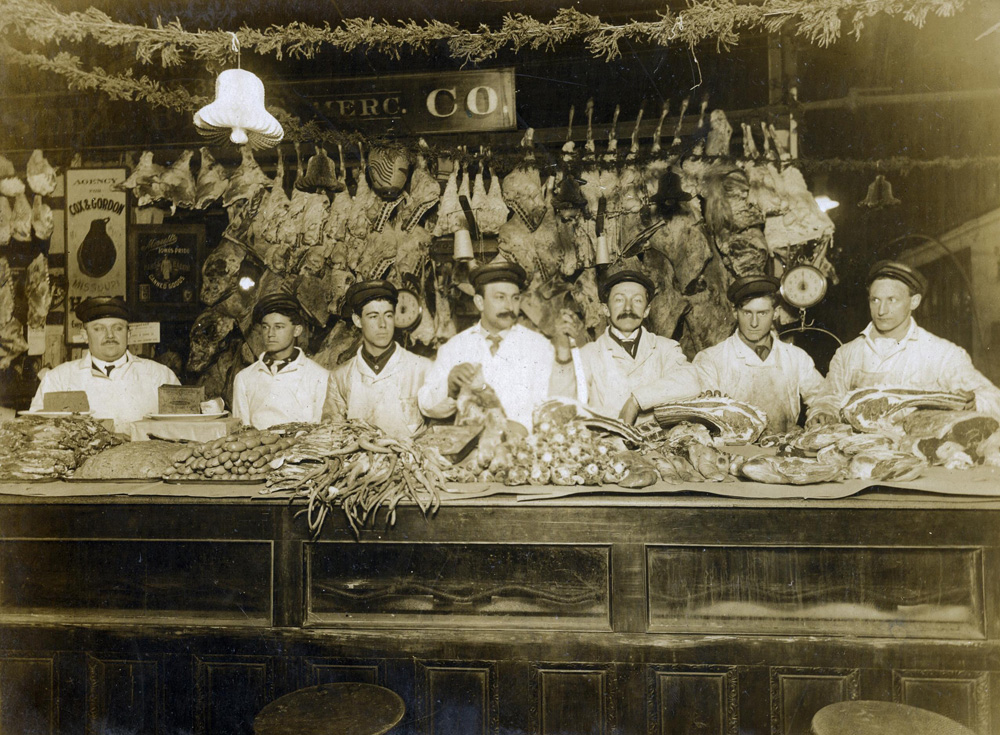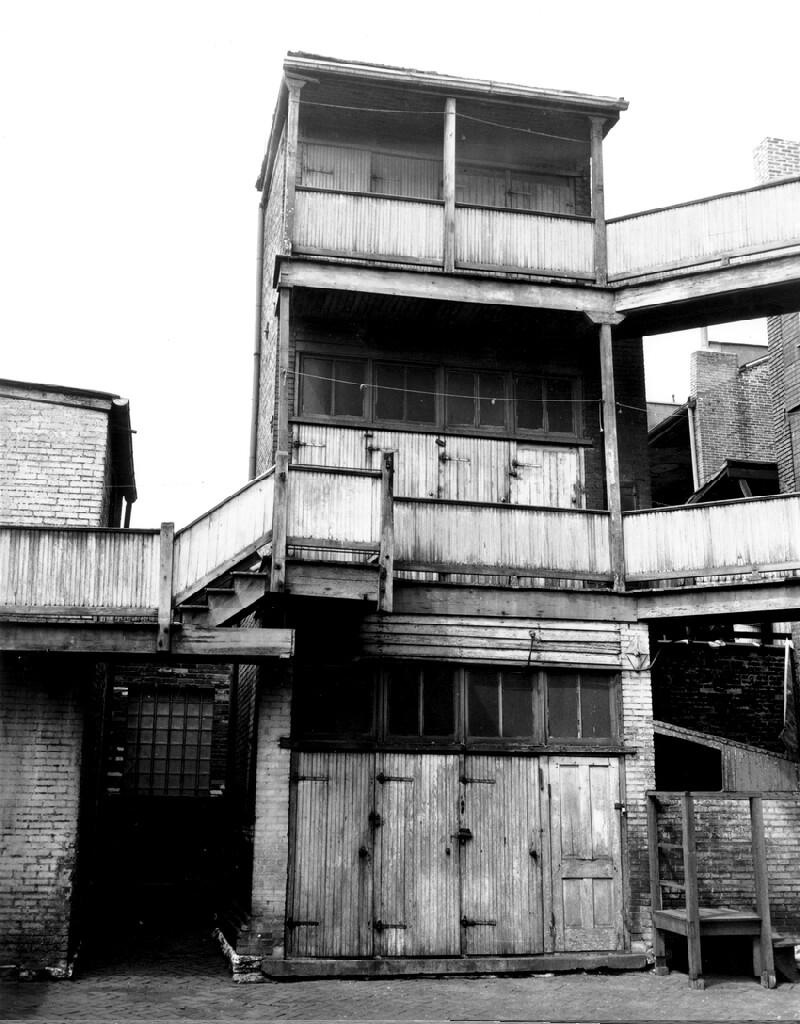I found this interesting article on the Internet today. I always wondered what life was like in the “good
old days”, but after reading this, was it really the “good old days”? You have to wonder. I hope enjoy this article, it can found here: http://historyhappenshere.org/archives/7698.
19, June 2015
Missouri Listories
We are introducing a new column called "Missouri Listory," which explores our vast historical collections and features them in lists of wide-ranging topics. Our first post in this column was inspired by our current exhibit, A Walk in 1875 St. Louis. Although the era was known as the Gilded Age, we bring you 10 reasons why living in 1875 wasn't so wonderful.
1. 72-hour work weeks
Not only was it common to have such a demanding schedule, but also you would have been grateful to have it! The average work week for a laborer in 1875 consisted of six 12-hour days, with Sundays off. Most unskilled or semi-skilled workers toiled for about 20 cents an hour (about $4.45 today), and 9 out of 10 Americans died without any substantial property to pass on to family.
2. “Fresh” was a loose term.
In 1875, St. Louis police seized more than 57,000 pounds of meat that was moldy, diseased, or rotting from market vendors who were still trying to sell it. One in 20 pieces of meat for sale in St. Louis markets had a living parasitic worm infestation. Without refrigeration, meat rotted just hours after an animal was butchered. St. Louis Ladies Magazine recommended immediately searing the outside of any purchased meat to make it last a day or so longer.
3. Fewer than 1 in 5 homes had indoor toilets.
When nature called for the other unfortunate folks, they trudged out to their rickety backyard outhouse, which was sometimes shared with other families. These outhouses were often mere feet away from the family’s backyard well, which served as their source of drinking water. St. Louis health officer Arthur Barrett referred to backyard outhouses as “temples of indecency.”
4. In the late 1800s it was estimated that 10% to 15% of the American population had syphilis.
Need we say more?
5. The wafting aromas of Schaeffer’s Soap and Candle Works…
If you’re thinking of the pleasant scents wafting from a cozy candle store, think again. Schaeffer’s Soap and Candle Works at Washington Avenue and 20th Street was such a powerful punch in the nose that 1875-ers refused to build their homes within blocks of the company. The plant took in dead animals, bones, leftover food from hotels, and spoiled meat from butcher shops, then boiled it all together to extract tallow—hardened fat that is solid at room temperature—for candle making. Schaeffer’s was just one of many factories contributing to the unfathomable stench drifting over 1875 St. Louis.
6. Hurt on the job? Tough noogies, pal.
1875 St. Louis was a world with no Social Security, Medicare, health insurance, workers’ comp, or retirement plans. Dangerous low-wage labor jobs came and went daily and getting injured likely meant you were out of a job with nothing more than a kick out the door. Many a family fallen on hard luck wound up in a single-room tenement. It may have been the most terrifying time in their lives.
 Men standing in front of a saloon at Gravois Avenue and Kingshighway. Photograph in 1897. Missouri History Museum.
Men standing in front of a saloon at Gravois Avenue and Kingshighway. Photograph in 1897. Missouri History Museum.
7. Walking into the wrong saloon could quickly cost you more than a drink.
The 1875 St. Louis City Directory lists nearly 1,200 saloons (one per 100 drinking-age men), and some were certainly not for the faint of heart. They attracted a rough cast of characters that included thieves, gamblers, prostitutes, fortune tellers, and drunkards, and they were known to be a great place to go if you wanted to get in a fight or have your pockets lightened. An 1875 contemporary said of the riverfront saloons on Almond Street: “The luckless stranger that falls into these social pits may consider himself quite fortunate if he gets out without broken bones.”
8. Tricksters prowled the city looking for naïve “greenies.”
1875 St. Louis had no shortage of swindlers trying to fool “greenies,” as rural folks new to the big city were known. In May 1875 a trickster made more than $5,500 by selling fake property in an imaginary town called Vineland, Illinois. He claimed the town needed residents and if St. Louisans just paid a $2.25 notary fee, a lot in Vineland would be theirs. He sold 2,500 phony lots over three days and then vanished, never to be seen again.
9. Dr. Hezekiah E. Depp’s Dental Kit
If a trip to the dentist strikes fear in your heart today, be glad you were not alive in 1875. Without electric tools, sterilization, numbing agents, or anesthesia, the dentist’s office was the definition of dread. Preventative dentistry was almost nonexistent, and the cure-all for any tooth problem was extraction. This dental kit displays 145 picks, pokers, and pliers used by St. Louis dentist Hezekiah E. Depp. Many of the tools feature exotic materials like ivory and mother of pearl, which would have been much harder to sterilize than metal and may have led to further infections.
10. Committed a crime? Say hello to the County Workhouse.
Besides the city jail, criminals in 1875 were also sent to the St. Louis Workhouse at Broadway and Meramec streets. The workhouse’s main function was supplying crushed limestone for city streets. All day long, inmates toiled “making little stones out of big ones.” Women were sentenced to the workhouse right beside men, and in 1875 alone more than 1,100 women picked up their hammers and headed to the rock yards.
2015 isn’t looking so bad now, is it?
A Walk in 1875 St. Louis is open through February 14, 2016.
1. 72-hour work weeks
Not only was it common to have such a demanding schedule, but also you would have been grateful to have it! The average work week for a laborer in 1875 consisted of six 12-hour days, with Sundays off. Most unskilled or semi-skilled workers toiled for about 20 cents an hour (about $4.45 today), and 9 out of 10 Americans died without any substantial property to pass on to family.
2. “Fresh” was a loose term.
In 1875, St. Louis police seized more than 57,000 pounds of meat that was moldy, diseased, or rotting from market vendors who were still trying to sell it. One in 20 pieces of meat for sale in St. Louis markets had a living parasitic worm infestation. Without refrigeration, meat rotted just hours after an animal was butchered. St. Louis Ladies Magazine recommended immediately searing the outside of any purchased meat to make it last a day or so longer.
3. Fewer than 1 in 5 homes had indoor toilets.
When nature called for the other unfortunate folks, they trudged out to their rickety backyard outhouse, which was sometimes shared with other families. These outhouses were often mere feet away from the family’s backyard well, which served as their source of drinking water. St. Louis health officer Arthur Barrett referred to backyard outhouses as “temples of indecency.”
4. In the late 1800s it was estimated that 10% to 15% of the American population had syphilis.
Need we say more?
5. The wafting aromas of Schaeffer’s Soap and Candle Works…
If you’re thinking of the pleasant scents wafting from a cozy candle store, think again. Schaeffer’s Soap and Candle Works at Washington Avenue and 20th Street was such a powerful punch in the nose that 1875-ers refused to build their homes within blocks of the company. The plant took in dead animals, bones, leftover food from hotels, and spoiled meat from butcher shops, then boiled it all together to extract tallow—hardened fat that is solid at room temperature—for candle making. Schaeffer’s was just one of many factories contributing to the unfathomable stench drifting over 1875 St. Louis.
6. Hurt on the job? Tough noogies, pal.
1875 St. Louis was a world with no Social Security, Medicare, health insurance, workers’ comp, or retirement plans. Dangerous low-wage labor jobs came and went daily and getting injured likely meant you were out of a job with nothing more than a kick out the door. Many a family fallen on hard luck wound up in a single-room tenement. It may have been the most terrifying time in their lives.
 Men standing in front of a saloon at Gravois Avenue and Kingshighway. Photograph in 1897. Missouri History Museum.
Men standing in front of a saloon at Gravois Avenue and Kingshighway. Photograph in 1897. Missouri History Museum.The 1875 St. Louis City Directory lists nearly 1,200 saloons (one per 100 drinking-age men), and some were certainly not for the faint of heart. They attracted a rough cast of characters that included thieves, gamblers, prostitutes, fortune tellers, and drunkards, and they were known to be a great place to go if you wanted to get in a fight or have your pockets lightened. An 1875 contemporary said of the riverfront saloons on Almond Street: “The luckless stranger that falls into these social pits may consider himself quite fortunate if he gets out without broken bones.”
8. Tricksters prowled the city looking for naïve “greenies.”
1875 St. Louis had no shortage of swindlers trying to fool “greenies,” as rural folks new to the big city were known. In May 1875 a trickster made more than $5,500 by selling fake property in an imaginary town called Vineland, Illinois. He claimed the town needed residents and if St. Louisans just paid a $2.25 notary fee, a lot in Vineland would be theirs. He sold 2,500 phony lots over three days and then vanished, never to be seen again.
9. Dr. Hezekiah E. Depp’s Dental Kit
If a trip to the dentist strikes fear in your heart today, be glad you were not alive in 1875. Without electric tools, sterilization, numbing agents, or anesthesia, the dentist’s office was the definition of dread. Preventative dentistry was almost nonexistent, and the cure-all for any tooth problem was extraction. This dental kit displays 145 picks, pokers, and pliers used by St. Louis dentist Hezekiah E. Depp. Many of the tools feature exotic materials like ivory and mother of pearl, which would have been much harder to sterilize than metal and may have led to further infections.
10. Committed a crime? Say hello to the County Workhouse.
Besides the city jail, criminals in 1875 were also sent to the St. Louis Workhouse at Broadway and Meramec streets. The workhouse’s main function was supplying crushed limestone for city streets. All day long, inmates toiled “making little stones out of big ones.” Women were sentenced to the workhouse right beside men, and in 1875 alone more than 1,100 women picked up their hammers and headed to the rock yards.
2015 isn’t looking so bad now, is it?
A Walk in 1875 St. Louis is open through February 14, 2016.



